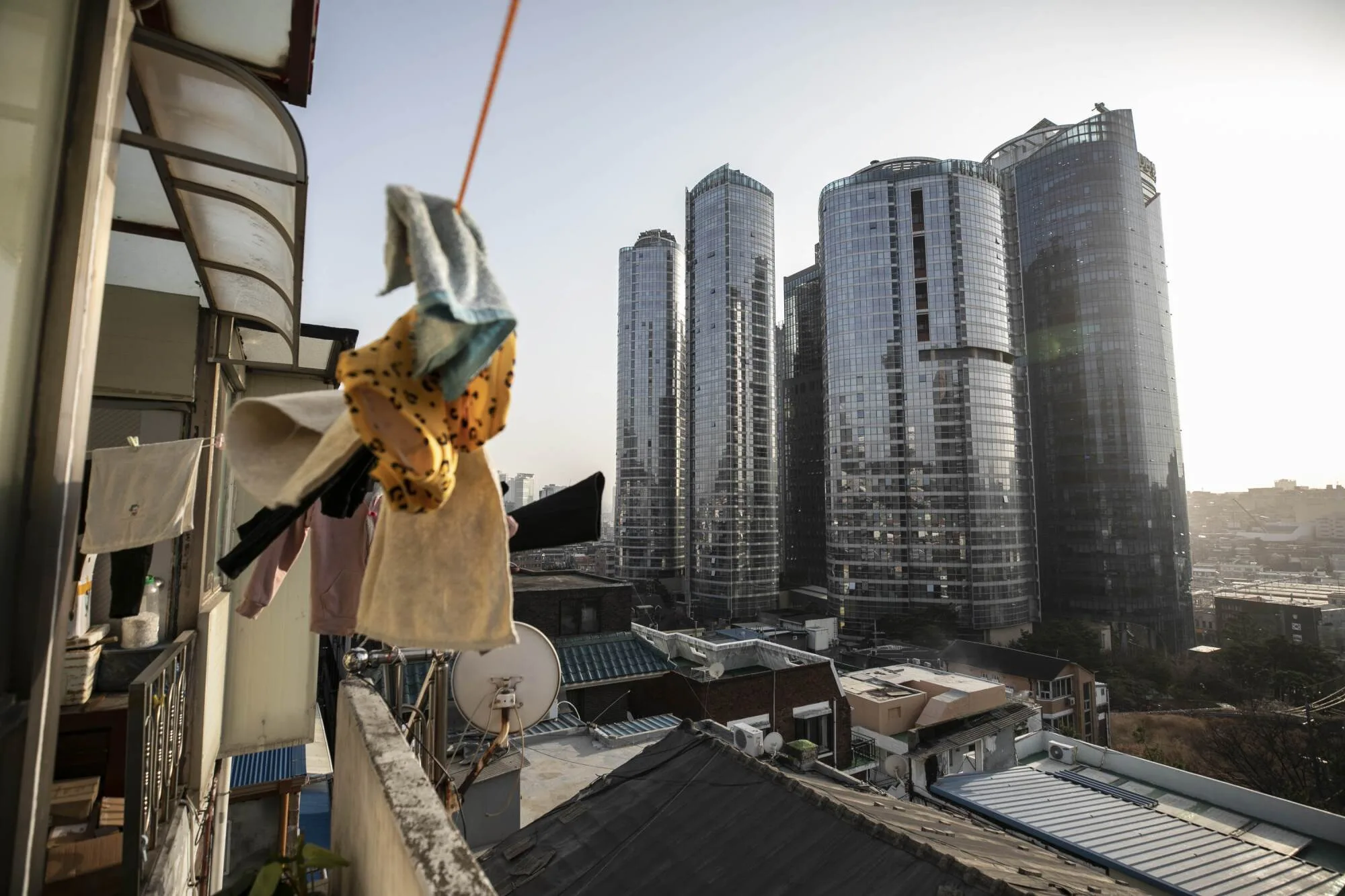Introduction
South Korea, often lauded for its rapid economic growth and technological advancements, is grappling with a less visible yet deeply troubling issue: the rise of the ‘Room Poor’ phenomenon. This term refers to the increasing number of South Koreans, including parents, who opt to live in tiny, rented rooms known as ‘goshiwon.’ These individuals, driven by escalating housing costs, stagnant wages, and fierce competition for education and employment, prioritize saving money over social interaction and personal comfort. This article delves into the motivations behind this drastic lifestyle choice, highlighting the immense pressures faced by families in a highly competitive society and raising concerns about the potential long-term consequences of such isolation on mental health and social well-being.
South Korea ‘Room Poor’: An Overview
The ‘Room Poor’ phenomenon is a reflection of the broader socioeconomic challenges in South Korea. As housing costs continue to soar and wages remain stagnant, many individuals find themselves unable to afford traditional housing. Goshiwon, originally designed as affordable accommodations for students preparing for exams, have become a refuge for a broader demographic, including parents and working professionals. These small rooms, often no larger than a closet, offer minimal amenities but come with the advantage of low rent, making them an attractive option for those looking to save money.
Economic Pressures Driving the Trend
South Korea’s economic landscape is marked by high living costs and intense competition in both education and employment. Housing prices, especially in major cities like Seoul, have skyrocketed, making homeownership an unattainable dream for many. At the same time, wages have not kept pace with inflation, putting additional financial strain on households. This economic squeeze has forced individuals to make tough choices, with some opting for the minimalistic lifestyle offered by goshiwon to reduce expenses and save for future needs.
Living Conditions in Goshiwon
Goshiwon are typically small, cramped spaces that provide the bare essentials. A typical room might include a bed, a small desk, and limited storage space. Shared facilities, such as bathrooms and kitchens, are common, adding to the sense of austerity. Despite these Spartan conditions, the appeal of goshiwon lies in their affordability and the opportunity they offer to save on housing costs. However, the lack of privacy, comfort, and social interaction can take a toll on the inhabitants’ mental and emotional well-being.
Social Isolation and Mental Health Concerns
The decision to live in goshiwon often comes at the cost of social isolation. The confined living spaces and the prioritization of financial savings over social activities can lead to a sense of loneliness and disconnection. This isolation is exacerbated by the competitive nature of South Korean society, where individuals may feel pressured to succeed at the expense of their social lives. The mental health implications of such isolation are significant, with potential increases in anxiety, depression, and other related conditions.
The Broader Societal Impact
The rise of the ‘Room Poor’ phenomenon highlights a stark contrast between South Korea’s image of prosperity and the internal struggles faced by many of its citizens. This trend underscores the urgent need for systemic solutions to address the root causes of financial strain and social isolation. Government intervention and societal support systems are crucial in providing affordable housing options, improving wage conditions, and fostering a more inclusive social environment.
Historical Context and Cultural Factors
The current trend of living in goshiwon can be traced back to South Korea’s historical and cultural context. The country’s rapid industrialization and urbanization in the latter half of the 20th century brought about significant economic growth but also led to increased living costs and social competition. The Confucian emphasis on education and family success has further intensified the pressure on individuals to perform, often at the cost of their personal well-being. This cultural backdrop plays a crucial role in understanding the motivations behind the ‘Room Poor’ phenomenon.
The Government’s Role and Policy Recommendations
Addressing the ‘Room Poor’ phenomenon requires concerted efforts from the government and policymakers. Affordable housing initiatives, such as the construction of low-cost apartments and the provision of housing subsidies, can alleviate some of the financial burdens on households. Additionally, policies aimed at improving wage conditions and reducing the cost of living are essential in ensuring that individuals are not forced into extreme measures to cope with economic pressures. Mental health support services and community-building programs can also help mitigate the social isolation experienced by those living in goshiwon.
Community and Societal Support Systems
Beyond government intervention, community and societal support systems play a vital role in addressing the challenges faced by the ‘Room Poor.’ Non-profit organizations, community groups, and social enterprises can provide valuable resources and support networks for individuals living in goshiwon. These initiatives can help foster a sense of community, reduce feelings of isolation, and provide practical assistance in areas such as job training, financial management, and mental health support.
The Human Stories Behind the Statistics
While the ‘Room Poor’ phenomenon is often discussed in terms of statistics and economic factors, it is essential to recognize the human stories behind these trends. Each individual living in a goshiwon has a unique narrative, shaped by personal experiences and challenges. Highlighting these stories can provide a more nuanced understanding of the phenomenon and emphasize the need for empathy and targeted support.
Personal Reflections: Living as ‘Room Poor’
For many, the decision to live in goshiwon is not just a matter of economic necessity but also a reflection of personal resilience and adaptability. Despite the hardships, some individuals find a sense of purpose and determination in their choice to prioritize financial stability. These personal reflections can inspire others facing similar challenges and contribute to a broader dialogue about economic survival and social well-being in contemporary South Korea.
Conclusion
The ‘Room Poor’ phenomenon in South Korea is a stark reminder of the deep-seated economic and social challenges faced by many of its citizens. While goshiwon offer a temporary solution to financial strain, the long-term implications of such living conditions on mental health and social well-being cannot be ignored. Addressing this issue requires a multifaceted approach, including government intervention, community support, and a cultural shift towards valuing mental health and social connections. By understanding and addressing the root causes of this trend, South Korea can work towards a more inclusive and supportive society for all its citizens.
FAQs
What is the ‘Room Poor’ phenomenon in South Korea?
The ‘Room Poor’ phenomenon refers to the increasing number of South Koreans choosing to live in small, rented rooms known as goshiwon due to financial strain.
Why are people choosing to live in goshiwon?
People opt for goshiwon to save money amidst rising housing costs, stagnant wages, and intense competition for education and employment.
What are the living conditions like in goshiwon?
Goshiwon typically offer minimal amenities in small, cramped spaces, with shared facilities such as bathrooms and kitchens.
What are the mental health implications of living in goshiwon?
The isolation and lack of social interaction in goshiwon can lead to increased anxiety, depression, and other mental health issues.
How can the government address the ‘Room Poor’ phenomenon?
Government intervention through affordable housing initiatives, wage improvements, and mental health support can help alleviate the issues faced by the ‘Room Poor.’
What role can community support systems play in addressing this issue?
Community groups and non-profits can provide valuable resources, support networks, and practical assistance to individuals living in goshiwon, helping to reduce isolation and improve well-being.
============================================



